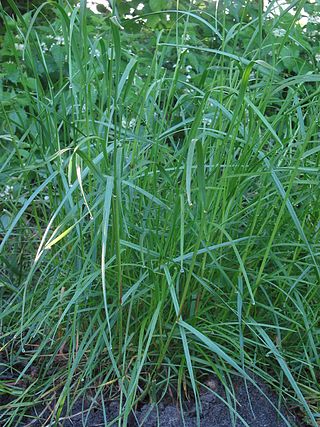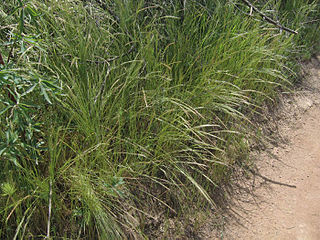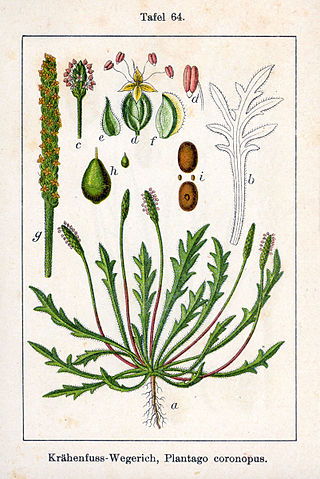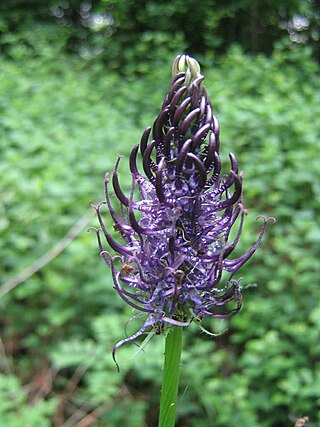
Campanula is the type genus of the Campanulaceae family of flowering plants. Campanula are commonly known as bellflowers and take both their common and scientific names from the bell-shaped flowers—campanula is Latin for "little bell".

Phyteuma is a genus of flowering plants in the family Campanulaceae, native to Europe and Morocco.

Centaurea montana, the perennial cornflower, mountain cornflower, bachelor's button, montane knapweed or mountain bluet, is a species of flowering plant in the family Asteraceae, endemic to Europe. It is widespread and common in the more southerly mountain ranges of Europe, but is rarer in the north. It escapes from gardens readily, and has thereby become established in the British Isles, Scandinavia and North America. This plant has become an invasive species in British Columbia, Canada. Centaurea montana grows in meadows and open woodland in the upper montane and sub-alpine zones, in basic areas. It grows to 30–70 centimetres (12–28 in) tall, and flowers mainly from May to August.

Scheuchzeria palustris, is a flowering plant in the family Scheuchzeriaceae, in which there is only one species and Scheuchzeria is the only genus. In the APG II system it is placed in the order Alismatales of the monocots.

Phyteuma orbiculare, common name round-headed rampion or Pride of Sussex, is a herbaceous perennial plant of the genus Phyteuma belonging to the family Campanulaceae.

Lolium perenne, common name perennial ryegrass, English ryegrass, winter ryegrass, or ray grass, is a grass from the family Poaceae. It is native to Europe, Asia and northern Africa, but is widely cultivated and naturalised around the world.

Sonchus arvensis, the field milk thistle, field sowthistle, perennial sow-thistle, corn sow thistle, dindle, gutweed, swine thistle, or tree sow thistle, is a species of flowering plant in the family Asteraceae. S. arvensis often occurs in annual crop fields and may cause substantial yield losses.

Vulpia myuros, the annual fescue, or rat's-tail fescue, is an annual flowering plant in grass family Poaceae. It was probably originally native to Eurasia, but it can now be found nearly worldwide as a naturalized species.

Campanula rapunculus, common name rampion bellflower, rampion, rover bellflower, or rapunzel, is a species of bellflower (Campanula) in the family Campanulaceae.
NVC community CG3 is one of the calcicolous grassland communities in the British National Vegetation Classification system. It is one of four communities of rank, tussocky grassland associated with low levels of grazing, within the lowland calcicolous grassland group.

Hypericum maculatum, commonly known as imperforate St John's-wort, or spotted St. Johnswort, is a species of perennial herbaceous flowering plant in the family Hypericaceae. It is native to Europe and Western Asia where it grows in moist meadows.

Plantago coronopus, the buck's-horn plantain, is a herbaceous annual to perennial flowering plant in the family Plantaginaceae. Other common names in the US and Italy include minutina and erba stella.

Phyteuma spicatum, the spiked rampion, is a herbaceous perennial plant in the family Campanulaceae. It is common across much of Europe. Its common names include raiponce en épi (French), Ährige Teufelskralle (German), Ährige Rapunzel, and Raponzolo giallo (Italian).

Hypericum hirsutum is a species of flowering plant in the family Hypericaceae, commonly known as hairy St John's-wort. It is found in Western Europe.

Physoplexis comosa, the tufted horned rampion, is a species of flowering plant in the family Campanulaceae, native to alpine Europe. It is the only species in its genus, and was formerly included in Phyteuma. Molecular evidence closely links this species with Phyteuma nigrum.

Eriophorum scheuchzeri is a species of flowering plant in the sedge family known by the common names Scheuchzer's cottongrass and white cottongrass. It has an arctic circumpolar and circumboreal distribution in the Northern Hemisphere. It can be found in Alaska, across Canada, in the Arctic islands, Greenland, Iceland, and across Eurasia. Disjunct occurrences exist in the Rocky Mountains, in the high mountains of southern Europe and on Mount Daisetsu in Japan and some other Asian mountains.

Reseda phyteuma, common name rampion mignonette or corn mignonette, is a species of flowering plant in the family Resedaceae.

Phyteuma sieberi, the horned rampion, is a species of herbaceous perennial plant in the family Campanulaceae. It is native to the South-eastern Alps, where it grows on limestone slopes. It was named after Franz Sieber, a 19th-century Bohemian botanist.

Phyteuma betonicifolium, common name betony-leaved rampion, is a species of flowering plant in the family Campanulaceae.

Phyteuma (P) nigrum, the black rampion, is a relatively rare species of plant in the family Campanulaceae. P. nigrum is located in central to northern Europe, primarily concentrated in Scandinavia. Much progress is yet to be made in forming concrete evolutionary relationships within this family and between the genera, but the molecular data from P. nigrum has contributed to the progress made in completing the evolutionary tree. The decrease in P. nigrum numbers over the past few decades has prompted the investigation into the reasons behind such a decline, leading to the conclusion that the factors that lead to a healthy P. nigrum population also run the risk of harming the population if not in just the right amount. The delicate nature of this organism makes its survival and reproductive success that much more uncertain.





















